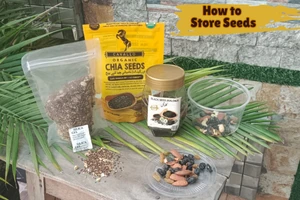What Is a Seed? Understanding the Basics of Plant Reproduction
Published: 16 Jun 2025
Greetings, green fingers!
What is a seed, and why is it like nature’s miniature factory? Just as a factory produces goods with all the materials in one place, a seed contains everything needed to produce a plant, from roots to leaves. Seeds are essential to life on earth, from the grains in your meal to the forests around you.
In this article, Sheila, a botanist with seven years of experience, will explore what a seed is, seed anatomy, how seeds form, types of seeds, why seeds are important, seed dispersal, seed germination, seed dormancy, seeds in agriculture and conservation, and a conclusion with FAQs.
By reading this article, you’ll unlock the fascinating world of seeds and learn why they are crucial to plant life. Let’s open the door to this exciting journey!
What is a Seed?
Think of a seed as a tiny life capsule ready to grow when the conditions are suitable.
- A seed is a small, dormant packet of potential life.
- It contains an embryo and nutrients to fuel early growth.
- Like a treasure chest, it holds everything for plant creation.
- Seeds drive species survival, securing the plant kingdom’s future.
- They restore ecosystems, support wildlife and repair damaged land.
- Seeds increase genetic diversity, helping plants adapt to environments.
- Vital for agriculture, they ensure food supply and ecosystem balance.
Seed Anatomy
A seed holds several key components, each serving a distinct purpose to support its survival and development into a plant. Here are its core parts:
- Seed Coat
- Embryo
- Cotyledons
- Endosperm
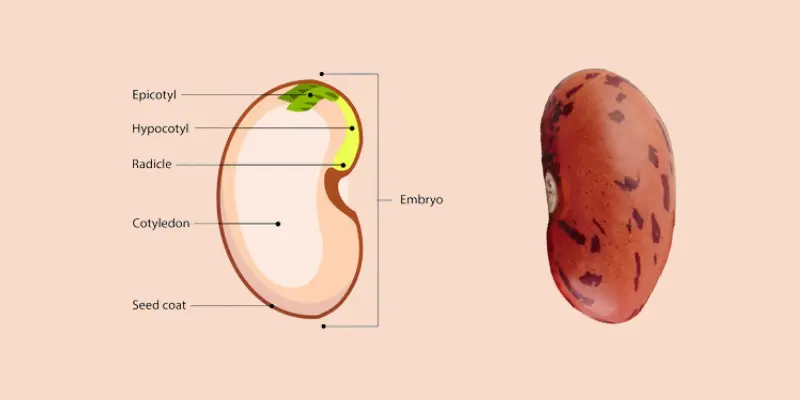
Here’s a table outlining the structure and function of each core component of a seed:
| Components | Structure | Function |
| Seed Coat | Outer protective layer covering the seed | shields the seed from physical damage and prevents water loss |
| Embryo | Developing plant within the seed includes root and shoot | The plant initially develops into roots, stems, and leaves after germination. |
| Cotyledons | Seed leaves within the embryo | Provide nutrients to the developing embryo before it can perform photosynthesis. |
| Endosperm | Nutrient-rich tissue surrounding the embryo | Supplies food to the embryo, especially in seeds where cotyledons are more absent. |
A seed is the beginning of a plant, a repository of its genetic information, and a promise of future life. Robin Wall Kimmerer, Braiding Sweetgrass
How Do Seeds Form?
This process shows the amazing transformation of a flower into a seed, highlighting each step along the way. Here are the main two ways of seed formation:
- Pollination
- Fertilization
Pollination
Pollination acts like a delivery service, transferring pollen (the male package) from the anther to the stigma (the female reproductive part) through wind, water, or pollinators like bees and butterflies.
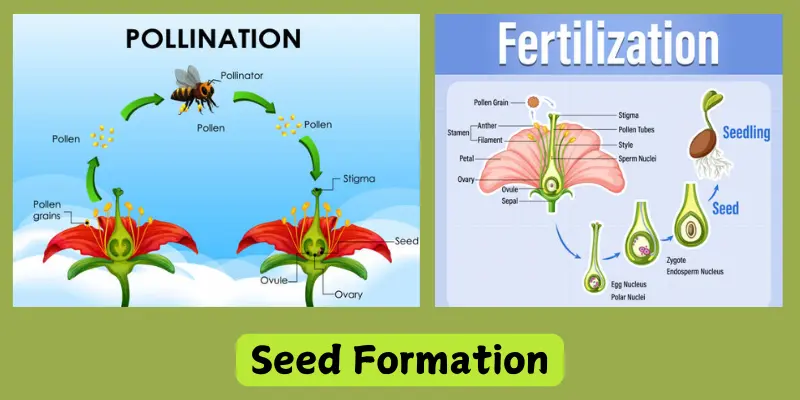
Fertilization
Fertilization is like an essential fitting into a lock. Pollen travels to the ovule, triggering seed formation. The surrounding flower part develops into a fruit, protecting the seed.
Types of Seeds
Seeds are divided into two main types
- Monocotyledonous Seeds
- Dicotyledonous Seeds
1. Monocotyledonous Seeds (Monocots)
- Monocots have one seed leaf, like a single starting gear.
- They feature parallel veins, giving leaves a sleek appearance.
- Their root system spreads widely, anchoring the plant firmly.
- Example: Corn
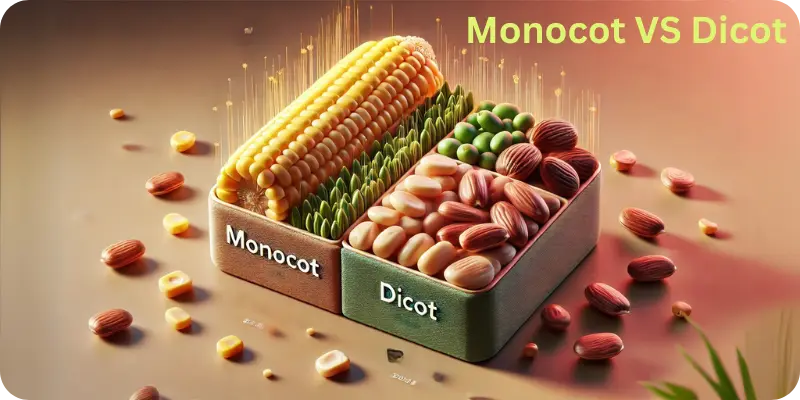
2. Dicotyledonous Seeds (Dicots)
- Dicots contain two seed leaves, resembling a pair of wings.
- They display branching veins, adding texture to each leaf.
- Their taproot grows deep, providing robust and stable support.
- Example: Beans
Why Are Seeds Important?
Seeds are a fundamental part of plant life, vital to reproduction, and provide essential human and animal resources.
Role in Plant Reproduction
Seeds play a crucial role in helping plants reproduce and continue their species. Like a building blueprint, seeds carry all the information needed to create a new plant. When conditions are right, the seed will grow into a new plant, ensuring the species’ survival across generations.
Importance For Humans
Seeds provide us with many of the essential items we use in everyday life. Below are some common examples:
Seed Importance in Different Aspects:
| Category | Example | importance |
| Food | Wheat, Rice, Beans, Peas | Provides essential nutrients and staple foods for people around the world |
| Spicy | Mustard, Coriander, Nutmeg | Add flavour and aroma to dishes, widely used in cooking and food preservation. |
| Oils | Sunflower oil, soybean oil, and coconut oil | Used in cooking, food processing, and as a base for many skincare products. |
| Reproduction | Seeds from flowering plants and trees | Ensure the survival and growth of plant species across different environments. |
| Environment | Ecosystem Seeds | Support biodiversity by helping plants grow and sustain animal habitats. |
Seed Dispersal: How Do Seeds Travel?
Seed dispersal is nature’s way of spreading seeds across new areas, like tossing confetti to help plants find fresh soil. I’ve watched dandelion seeds float away in the wind in my garden, landing far enough to start new growth.
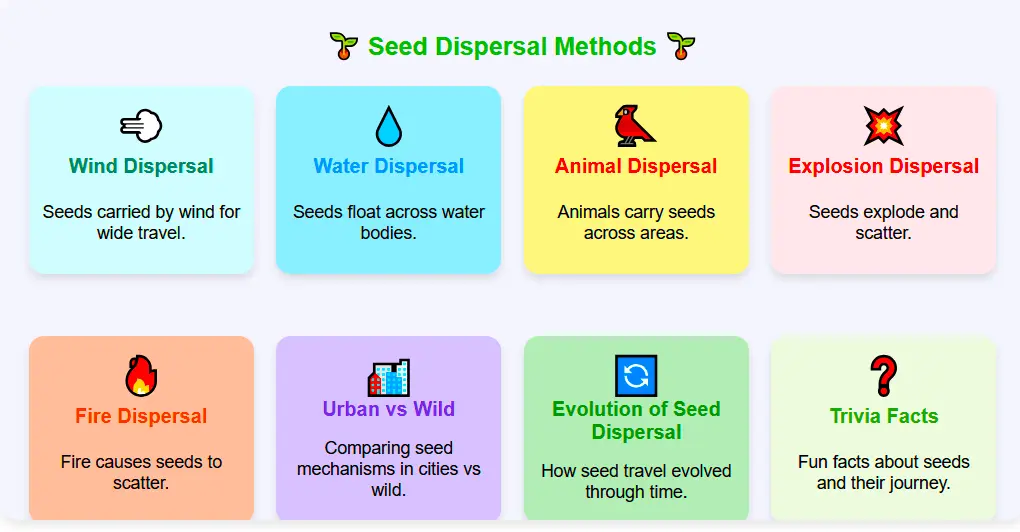
This spreading technique prevents overcrowding and gives each seed a better chance to thrive. Seeds can disperse in different ways.
- Wind
- Water
- Animals
The seeds are travellers; they hitchhike on the wind, water, and the backs of animals, finding new homes to growHope Jahren, Lab Girl
Seed Germination: How Do Seeds Grow?
Seed germination is like waking up a sleeping plant inside a tiny shell. When given water, oxygen, and the right warmth, the seed begins to sprout, turning into a young plant.
In my experience, I’ve seen seeds quickly spring to life after a good soaking, watching as they push roots into the soil and shoot into the light. This initial growth sets the stage for the plant’s entire journey.
Here are the main steps of seed germination.
- Imbibition
- Activation
- Radicle Emergence
- Imbibition: The seed absorbs water from its surroundings, swelling and breaking the seed coat, allowing it to take in vital nutrients.
- Activation: After absorbing water, the seed activates its internal processes. It uses stored food to fuel its growth, like a car starting after being fueled.
- Radicle Emergence: The radicle, or the first root, emerges from the seed coat. As it descends into the soil, it acts like an anchor for the seedling and stores nutrients and water.
Factors Needed for Germination
Several key factors ensure that seeds germinate successfully. These elements act like a perfect recipe for growth:
- Water
- Temperature
- Oxygen
- Light
Seed Dormancy and Viability
Seeds are like tiny time capsules, waiting for the perfect conditions to grow. Whether they sprout right away or lie dormant for years, their ability to survive depends on viability and dormancy.
What is Seed Dormancy?
Seed dormancy is a natural survival mechanism that allows seeds to remain inactive, sometimes for years, until conditions like moisture, temperature, and light are ideal for growth. As some animals hibernate to survive harsh seasons, seeds stay dormant to protect themselves from unfavourable conditions.
What Makes a Seed Viable?
A seed’s viability refers to its ability to germinate and develop into a healthy plant. A viable seed can remain dormant for years. It can grow again if it receives the right conditions, such as water, oxygen, and temperature.
Seeds in Agriculture and Conservation
Seeds are blueprints for builders in agriculture; they are vital to growing successful crops. Just as a good blueprint helps builders create strong structures, high-quality seeds help farmers produce plentiful harvests and protect plant diversity for the future. I will discuss two main aspects.
- Why are high-quality seeds important?
- Conservation of wild seeds
1. Why Are High-Quality Seeds Important?
High-quality seeds are essential because:
- Farmers need seeds that grow well to produce more crops. High-quality seeds are bred to resist diseases and adapt to different weather conditions. It helps crops grow strong and produce a good harvest.
- When farmers choose better seeds, they build a strong foundation for successful farming and help ensure food security.
Seeds hold the future of agriculture; they are the bedrock of food security and plant biodiversityVandana Shiva, Stolen Harvest.
2. Conservation of Wild Seeds
Wild seeds can be conserved because:
- Seed banks play a vital role in preserving the seeds of endangered plant species for future use. By storing seeds under controlled conditions, these facilities safeguard genetic diversity, ensuring that rare plants can be reintroduced into their natural habitats when necessary.
- This preservation effort is crucial for maintaining ecosystems and supporting biodiversity in the face of environmental changes and habitat loss.
| Do you know? |
|---|
|
Final Verdict: Seed is a Heart of Life ❤️🌱
So, guys, it’s time to wrap up. In this article, we’ve covered what a seed is in detail, from its anatomy and formation to its essential role in sustaining life.
💡My recommendation? Try growing something from seed yourself! It’s a rewarding experience that connects you directly with nature and gives insight into the life cycle of plants. Seeds are tiny, but their impact is enormous.
If this article inspired you, check out our other articles for more ways to engage with nature, and don’t forget to share this knowledge with friends!
FAQs for “What is a Seed?”
You can read these frequently asked questions to learn more about seeds:
A seed is a small structure containing an embryo and stored nutrients. Under favorable conditions, it can grow into a new plant, ensuring the survival of plant species.
Seeds form through pollination and fertilization, where pollen reaches an ovule. This process creates a fertilized egg, which develops into a seed within the flower.
A seed consists of a seed coat, embryo, cotyledons, and endosperm. These parts protect the seed, provide nutrients, and enable it to grow into a plant.
Seeds are vital for plant reproduction, food production, and biodiversity. They ensure ecosystems thrive, provide essential crops, and sustain life on Earth.
Monocots have one seed leaf, while dicots have two. These differences affect their root systems, leaf patterns, and overall growth.
Seeds germinate when they absorb water and activate stored nutrients. The radicle (root) emerges first, followed by the shoot, starting plant growth.
Seed dormancy is a survival mechanism where seeds remain inactive. They sprout only when environmental conditions are suitable for growth.
Seeds disperse through wind, water, animals, or mechanical bursts. This process helps plants spread to new areas and grow successfully.
Seeds need water, oxygen, the right temperature, and sometimes light. These conditions trigger germination and support the plant’s development.
Conserving seeds preserves biodiversity and protects endangered species. It also ensures future food security and supports ecological balance

- Be Respectful
- Stay Relevant
- Stay Positive
- True Feedback
- Encourage Discussion
- Avoid Spamming
- No Fake News
- Don't Copy-Paste
- No Personal Attacks



- Be Respectful
- Stay Relevant
- Stay Positive
- True Feedback
- Encourage Discussion
- Avoid Spamming
- No Fake News
- Don't Copy-Paste
- No Personal Attacks

